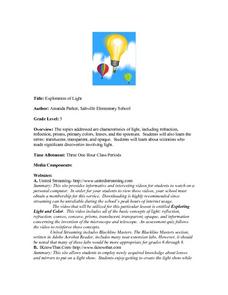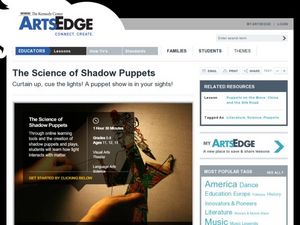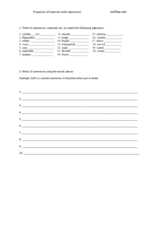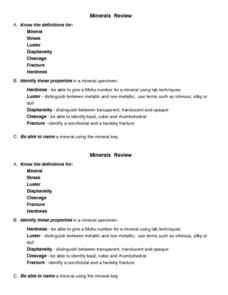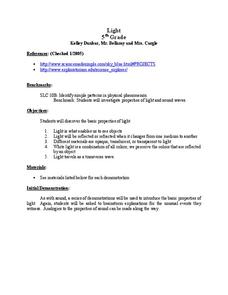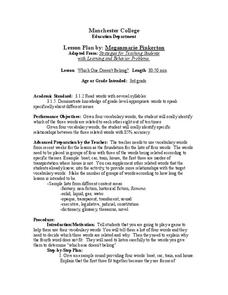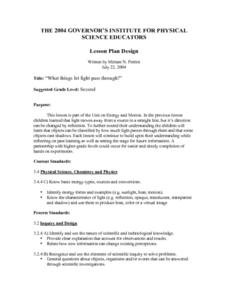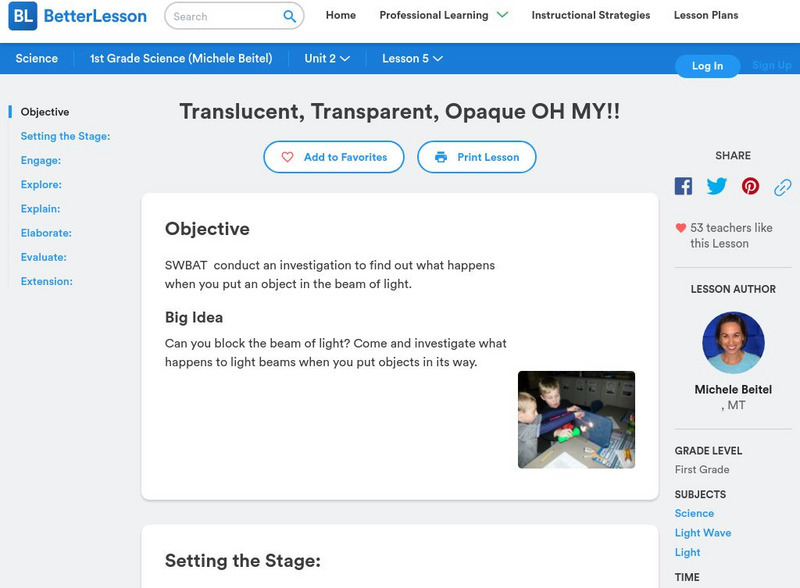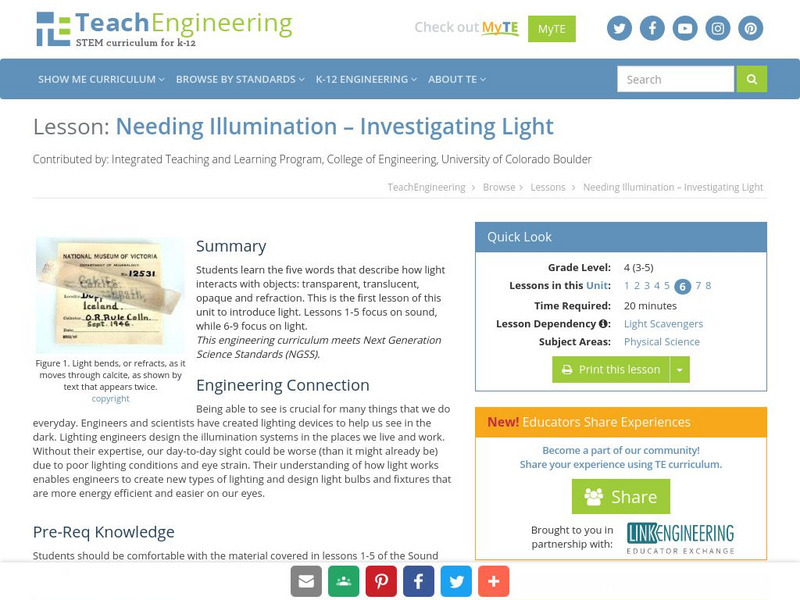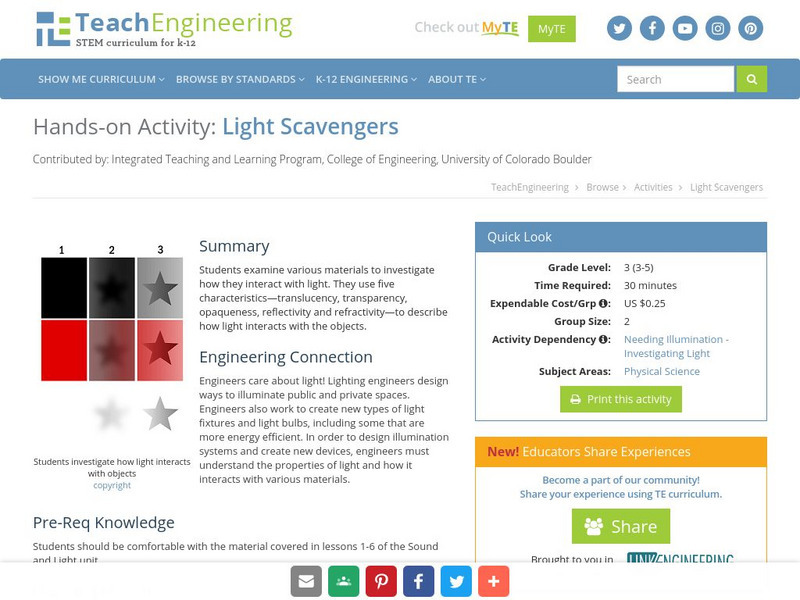Curated OER
Exploration of Light
Fifth graders observe the video, Exploring Light and Color. They access a website to create their own light show. They conduct lab experiments to investigate refraction, reflection,and other light-related topics.
Curated OER
The Science of Shadow Puppets
Students explore the art of shadow puppetry. In this performing arts lesson, students study the functions of lighting in the puppet theater as they examine the transmission, absorption, and reflection of light. As a culminating activity,...
Curated OER
Creating Station Models
Students review weather conditions at various cities and create station models on a weather map.
Curated OER
Properties of Materials (with adjectives)
Help your students write descriptive lab reports! Designed for ESL students but useful for mainstreamed kids as well, the activity prompts students to think of substances that match twenty given adjectives ("salt" for "soluble," for...
Curated OER
Is it Permeable?
The question is posed, is it permeable or impermeable, it's up to your critical thinkers to determine the answer. This presentation provides several scientific concepts related to permeability and the properties of matter alongside...
Curated OER
Starring...Bears!
Students illustrate a First Nations' legend. In this legend of bears lesson, students read several legends which involve bears and groups of stars or constellations. After reading, students illustrate portions of the stories....
Curated OER
Minerals Review
In this earth science worksheet, students review the basic characteristics of minerals in the common categories of them all.
Curated OER
Underwater Sea Garden: Washes
After modeling by the instructor, young artists practice wash, wet-on-wet, wet-on-dry, and dry-on-dry painting techniques.
Curated OER
Light
Fifth graders sit in their seats with the lights on and then the teacher turns off the lights. After their eyes have adjusted, they vote on what colors of construction paper are being held up. The lights are then turned back on and...
Curated OER
How does the Amount of Light Affect a Photogram?
Learners observe pictures of themselves using film and discuss how they think the image is processed to produce a photograph. They are introduced to photogram paper comparing it to photograph paper but understanding that no film is...
Curated OER
Which One Doesn't Belong?
Third graders identify words that are related with 80% accuracy. Given a list of four vocabulary words, 3rd graders identify specific relationships between three of the four words. They also identify which of the four words are not...
Curated OER
Exploring Microscopes
Students explore the parts of a microscope. In this microscope lesson, students examine simple and compound microscopes. Students discover how the parts of a microscope work together to generate an image.
Curated OER
What things let Light Pass Through?
Second graders classify objects according to how well light can pass through them and predict how well objects will transmit light. They experiment with objects to verify predictions while collecting, recording, and interpreting data...
Curated OER
Mineral Properties
In this earth science worksheet, students look at the properties that are common to identifying minerals and the types of observations one can make.
Alabama Learning Exchange
Alex: Translucent, Transparent, and Opaque Objects
Young scholars will become familiar with transparent, translucent, and opaque objects. Students predict whether items are transparent, translucent, or opaque. Finally, young scholars will show what they have learned by producing a song,...
Science Struck
Science Struck: Translucent, Transparent, and Opaque Materials
The definitions of transparent, translucent, and opaque can be found here. The article explains how the density of a material and its ability to absorb light determine which of these three properties it has. A list of examples is given...
Better Lesson
Better Lesson: Translucent, Transparent, Opaque Oh My!!
Can you block the beam of light? Young scholars will investigate what happens to light beams when you put objects in its way. These tests will allow them to learn new vocabulary (translucent, transparent, opaque) and discover how these...
TeachEngineering
Teach Engineering: Needing Illumination: Investigating Light
This is the first instructional activity of this unit to introduce light. In this instructional activity, students learn the five words that describe how light interacts with objects: "transparent," "translucent," "opaque," "reflection"...
Alabama Learning Exchange
Alex: Geometric Shadows
Students will identify objects as translucent, transparent, or opaque. Upon seeing the shadow of the opaque object, students will identify the geometric figure created by the shadow.This lesson plan was created as a result of the Girls...
ClassFlow
Class Flow: Introduction to Light
[Free Registration/Login Required] This flipchart introduces fifth graders to the science of light. Principles such as transparent, translucent, opaque, reflection, and refraction are covered. Concave and convex mirrors and lenses are...
Ducksters
Ducksters: Physics for Kids: Light
Kids learn about the science of light. Energy made of waves and particles called photons traveling at the top speed in the universe. What is refraction? The difference between transparent, translucent, and opaque.
E-learning for Kids
E Learning for Kids: Science: Winery: Why Can We See Through Some Objects but Not Others?
Learn about the properties of materials in their interactions with light, including whether they are opaque, transparent, or translucent, and which of these produce shadows.
TeachEngineering
Teach Engineering: Light Scavengers
In this activity, students examine various materials and investigate how they interact with light. Students use five new vocabulary words (translucent, transparent, opaque, reflection and refraction) to describe how light interacts with...
ClassFlow
Class Flow: What Is Light?
[Free Registration/Login Required] This flipchart reviews the characteristics of light and its properties. Students are given examples of reflection, refraction, and lens types. An assessment component is included.
